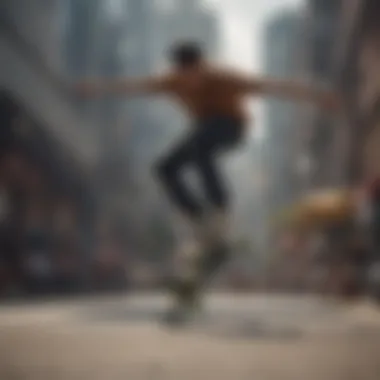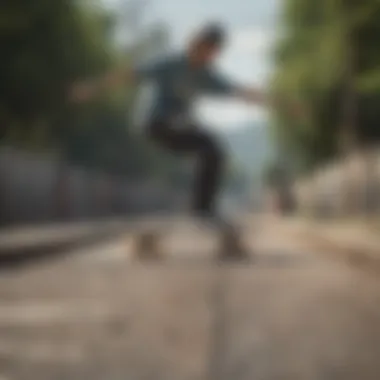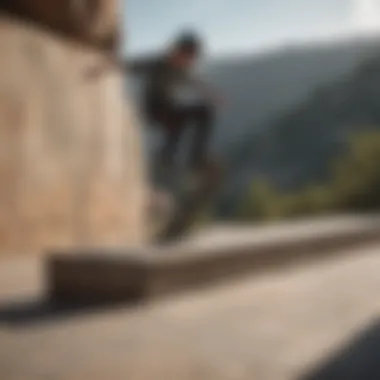Unlocking Skateboard Mastery: The Ultimate Guide to Perfecting Tricks


Extreme Sports Overview
- Skateboarding is a popular extreme sport with a rich history dating back to the 1950s when surfers in California sought an exciting alternative on land. The sport has evolved significantly, incorporating a plethora of tricks and maneuvers that push the boundaries of what is possible on a skateboard. To engage in skateboarding, minimal equipment is required, including a skateboard, appropriate footwear, and protective gear such as helmets and knee pads. Safety is paramount in this high-energy sport, with key tips emphasizing the use of proper gear, practicing in designated areas, and understanding and respecting one's skill level. Statistics indicate a steady rise in skateboarding participation globally, highlighting its enduring appeal and challenging nature.
Techniques and Training
- Mastering skateboard tricks involves a blend of dedication, coordination, and practice. For beginners, foundational techniques such as balancing, pushing, and turning lay the groundwork for more complex maneuvers. Training should focus on building core strength, flexibility, and agility to enhance performance and prevent injuries. Advanced skaters can explore intricate tricks like kickflips, heelflips, and 360 spins, mastering the art of timing and control. Regular workout routines incorporating cardio, strength training, and balance exercises foster skill development and overall fitness within the skateboarding realm.
Workout schedules need to be adapted according to individual proficiency levels, gradually intensifying to challenge and improve current skills. Noteworthy techniques for experienced athletes may include grinds, slides, and ramp maneuvers, requiring finesse and precision to execute seamlessly. Regardless of skill level, consistent practice and patient progress tracking are key to honing abilities and elevating performance in this dynamic sport. Incorporating a variety of training activities, from flat ground drills to custom ramp setups, is essential to maintain interest and skill growth over time.
Introduction
Skateboarding, a form of self-expression through intricate maneuvers on a wheeled board, has evolved into a highly dynamic and challenging sport that attracts enthusiasts worldwide. In this article, we delve deep into the art of mastering skateboard tricks, a fundamental aspect that distinguishes skillful riders from amateurs. Understanding the nuances of skateboard tricks is essential for individuals seeking to elevate their performance and stand out in the skateboarding community. By comprehending the mechanics and principles underlying these tricks, riders can hone their abilities and embark on a journey towards becoming proficient skateboarders.
Understanding Skateboard Tricks
The Importance of Proper Form
Skateboard tricks demand precision and finesse, where the significance of proper form becomes evident. A crucial element in executing tricks effectively, proper form ensures optimal balance, control, and technique utilization. Wrong form can lead to failed attempts, injuries, and performance inconsistencies. Emphasizing correct posture, body positioning, and motion sequences, mastering proper form is key to unlocking the full potential of skateboard tricks. Riders who prioritize form refinement witness substantial improvements in trick execution, fluidity, and style, setting them apart in the skateboarding realm.
Basic Components of a Skateboard Trick
At the core of every skateboard trick lie its basic components, foundational elements that determine the trick's complexity and visual appeal. These components encompass the setup, execution, and landing phases, each requiring meticulous attention to detail. From understanding board positioning and foot placement to coordinating movements and timing, mastering the basic components is pivotal for executing tricks seamlessly. By dissecting tricks into their constituent parts, riders can practice and refine specific aspects, gradually enhancing their overall performance and expanding their trick repertoire.
Beginner Tricks
Beginner tricks play a crucial role in setting the foundation for mastering more advanced skateboard maneuvers. They serve as the building blocks upon which skaters can develop their skills and progress. Understanding beginner tricks is essential for novice riders as it helps them grasp fundamental techniques and gain confidence on the board.
Ollie
Foot Placement
Foot placement is a fundamental aspect of mastering the Ollie trick. The precise positioning of the front and back feet on the skateboard determines the height and control of the Ollie. Placing the front foot just behind the front bolts and the back foot on the tail allows skaters to achieve optimum balance and leverage when executing the trick.


Pop and Slide Technique
The pop and slide technique is pivotal in the Ollie maneuver as it involves the coordinated movement of the legs to create the characteristic lift of the skateboard. By applying pressure on the tail to pop the board while simultaneously sliding the front foot towards the nose, skaters can propel the board into the air and level it out mid-flight for a smooth landing.
Kickflip
Mastering the Kickflip requires finesse in two key areas: flicking the board and catching it in midair. Each of these components contributes to the success and style of the trick, making them essential skills for any skateboarder looking to progress to intermediate level tricks.
Flicking the Board
A successful Kickflip hinges on the skater's ability to flick the board with the front foot in a swift and controlled motion. The angular precision and force applied during the flick dictate the speed and rotation of the board. Proper timing and technique play a critical role in achieving a clean and precise flip.
Catching the Board in Midair
Catching the board in midair is the culmination of a well-executed Kickflip. Skaters must anticipate the board's rotation, extend their legs to meet the underside of the board, and absorb the impact upon landing. Mastering this skill not only enhances the trick's aesthetics but also ensures a smooth and controlled descent back to the ground.
Intermediate Tricks
Skateboarding is a realm where progression is paramount. The intermediate level marks a significant step for skaters, delving into more complex maneuvers beyond the basic tricks. In this guide on mastering skateboard tricks, the section dedicated to Intermediate Tricks serves as a crucial bridge between the foundational ollies and kickflips and the intricate advanced techniques. Here, riders elevate their proficiency, refining control and coordination while exploring new challenges to expand their skill set. Intermediate Tricks not only showcase a skater's evolving prowess but also serve as a platform for experimentation and creative expression.
Heelflip
Navigating through the realm of skateboard tricks, the Heelflip stands out as a fundamental maneuver that challenges riders with its technical demands. With a focus on precise footwork and spatial awareness, mastering the Heelflip requires a balance of finesse and timing. This trick involves swift movements that demonstrate a skater's ability to manipulate the board mid-air gracefully. The execution of a Heelflip epitomizes the blend of skill and style that characterizes the artistry of skateboarding.
Back Foot Placement
When dissecting the intricacies of a Heelflip, the back foot placement plays a pivotal role in initiating and controlling the board's rotation. By positioning the back foot precisely on the tail of the skateboard, riders can generate the necessary pop and leverage to execute a seamless Heelflip. This strategic placement allows for optimal power transfer, enabling skaters to guide the board through its rotation with control and accuracy. Despite its technical challenges, mastering back foot placement empowers riders to unlock the full potential of their Heelflip and enhance the overall fluidity of their tricks.
Execution and Landing
The flawless execution and landing of a Heelflip demand unwavering focus and precision from skaters. From the precise flick of the heel to the subtle adjustments in body positioning, every movement contributes to the successful completion of the trick. Securing a stable landing post-rotation reinforces a skater's sense of accomplishment and reaffirms their mastery of the Heelflip. However, achieving consistency in execution and landing requires dedication to honing technique and continuous refinement of timing and control. Mastering the art of Heelflips not only adds diversity to a skater's repertoire but also fosters a deep sense of satisfaction in conquering a technically demanding trick.
Boardslide
As riders venture further into the realm of skateboard progression, the Boardslide emerges as a quintessential trick that tests both technical aptitude and nerve. This maneuver challenges skaters to maintain balance and control while sliding along a rail or ledge, showcasing their ability to synchronize movement and precision in a dynamic motion.


Approach and Pop
Diving into the intricacies of a Boardslide, the approach and pop lay the groundwork for a successful execution. Skaters must approach the rail with confidence and precision, aligning their body with the intended path of the slide. The pop, a swift yet controlled lift of the board onto the rail, sets the stage for the smooth transition into the slide. Mastering the art of approach and pop allows riders to initiate the trick seamlessly, setting the tone for a visually captivating and technically sound Boardslide.
Balancing on the Rail
The crux of a Boardslide lies in the skater's ability to maintain balance and composure while gracefully gliding along the rail. Achieving equilibrium on the rail requires a delicate interplay of weight distribution and muscle control, ensuring a smooth and controlled slide from start to finish. Skaters must focus on centralizing their weight, adjusting it as needed to navigate the slide with finesse. Mastering the art of balancing on the rail not only showcases a skater's technical proficiency but also underscores their ability to exude confidence and poise in challenging terrains.
Advanced Tricks
In the intricate world of skateboarding, mastering advanced tricks proves to be the pinnacle of skill and finesse. These maneuvers go beyond the basics, requiring a deep understanding of techniques and a commitment to pushing the boundaries of what is possible on a skateboard. Advanced tricks not only showcase a skater's proficiency but also serve as a platform for creativity and expression. Skaters who delve into advanced tricks elevate their status within the skateboarding community, earning respect and admiration from peers and spectators alike. These maneuvers demand focus, determination, and a willingness to conquer fear as skaters strive for perfection in execution and style.
Flip
Rotation Mechanics
A crucial element of the 360 flip is its intricate Rotation Mechanics. This aspect entails the board making a full three hundred and sixty-degree spin while simultaneously flipping. The seamless integration of rotation and flipping requires precise footwork, dexterity, and timing. The Rotation Mechanics of a 360 flip contribute significantly to a skater's ability to perform complex aerial maneuvers with fluidity and control. Skaters who master this aspect can execute visually stunning tricks that captivate onlookers and leave a lasting impression. Despite its complexity, perfecting the Rotation Mechanics of a 360 flip offers skaters a sense of accomplishment and opens doors to further mastery of advanced techniques.
Precision and Finesse
Another essential aspect of the 360 flip is Precision and Finesse in execution. Achieving the perfect balance between precision and finesse allows a skater to perform the trick with grace and style. Precision ensures that each movement is deliberate and calculated, leading to a flawless execution of the trick. On the other hand, finesse adds a touch of artistry and expertise, turning a simple trick into a mesmerizing display of skill. Skaters who prioritize Precision and Finesse in their 360 flip elevate the trick from a mere technical feat to a captivating performance that showcases their mastery of the craft.
Hardflip
Combining Kickflip and Frontside Shove-It
The Hardflip brings together elements of the Kickflip and Frontside Shove-It, blending these maneuvers into a seamless and dynamic trick. This combination requires a deep understanding of board control and foot placement to execute the trick with precision. The synchronous movement of the board spinning and flipping adds a layer of complexity that challenges skaters to master coordination and timing. By integrating the Kickflip and Frontside Shove-It, skaters enhance their repertoire of tricks and display a high level of technical prowess that sets them apart from their peers.
Landing and Stabilizing
A critical component of the Hardflip is the Landing and Stabilizing phase. Successfully landing a Hardflip involves absorbing the impact upon touchdown and maintaining control and balance to prevent a fall. Skaters must possess the agility and strength to absorb the landing impact while adjusting their body position to achieve stability. Stabilizing the board and body after landing demonstrates a skater's control and finesse, highlighting their mastery of the trick. Skaters who excel in Landing and Stabilizing the Hardflip not only impress with their technical skill but also showcase their ability to effortlessly transition from trick execution to controlled riding, solidifying their status as skilled practitioners of advanced skateboarding maneuvers.
Mastering Techniques
Skateboarding enthusiasts understand the critical role of mastering techniques in elevating their skills to impressive levels. Whether you are a novice or an experienced rider, honing your mastering techniques is vital for achieving precision and finesse in executing skateboard tricks. This section delves into the intricate details of perfecting your moves, focusing on the nuances that set apart average skaters from exceptional ones.


Practice Drills
Developing expertise in skateboard tricks requires commitment to rigorous practice drills that target specific aspects of performance refinement. By integrating purposeful drills into your routine, you can enhance your muscle memory and coordination, bolstering your ability to execute tricks with ease and fluidity.
Repetitive Execution
One of the fundamental pillars of skill development in skateboarding is repetitive execution. This practice involves consistently performing a trick or maneuver multiple times to ingrain muscle memory and improve fluency. The sheer act of repetition cultivates consistency in execution and refines the fine motor skills necessary for executing complex tricks effectively.
Incremental Progression
In tandem with repetitive execution, incremental progression plays a key role in skill advancement. This approach involves breaking down complex tricks into manageable steps and gradually increasing the level of difficulty as proficiency grows. Incremental progression empowers skaters to build confidence, master foundational elements, and steadily expand their repertoire of tricks, ensuring a systematic and sustainable path to mastery.
Safety Precautions
In the realm of skateboarding, safety precautions are paramount. Understanding and implementing safety measures can be the difference between an exhilarating ride and a potential trip to the emergency room. Regardless of skill level, all skateboarders must prioritize safety. In this section, we delve into the critical aspects of safety precautions, shedding light on their importance and impact.
When it comes to skateboarding, protective gear serves as the first line of defense against injuries. Helmets, knee pads, and elbow pads are vital components that can safeguard riders from the unpredictable nature of the sport. By investing in quality protective gear, skaters can minimize the risk of head trauma, fractures, and abrasions. Not only do these items offer physical protection, but they also provide peace of mind, enabling riders to push their limits with confidence.
Protective Gear
Helmets
Among the protective gear, helmets arguably take the top spot in terms of importance. A helmet is designed to shield the rider's head from impacts, reducing the likelihood of traumatic brain injuries. The key characteristic of helmets lies in their sturdy construction and shock-absorbing properties. This makes them a popular and indispensable choice for skaters of all levels. The unique feature of helmets is their adjustable straps and inner padding, ensuring a secure and comfortable fit for optimum protection. While helmets may feel slightly bulky, their unparalleled safety benefits far outweigh any minor inconvenience.
Knee and Elbow Pads
Moving on to knee and elbow pads, these accessories play a pivotal role in safeguarding the skater's joints during falls and tricks. The key characteristic of knee and elbow pads is their durable outer shell and soft cushioning, which absorb impact forces and reduce the risk of fractures or sprains. Skaters find knee and elbow pads beneficial due to their versatility and ability to provide targeted protection to vulnerable areas. One unique feature of these pads is their ergonomic design, ensuring a snug fit without restricting movement. While knee and elbow pads may hinder some flexibility, their undeniable advantages in injury prevention make them indispensable for any skateboarder aiming to prioritize safety.
Conclusion
In this final segment of the exhaustive guide on mastering skateboard tricks, the emphasis falls on the pivotal role played by dedication in achieving proficiency in this athletic pursuit. Dedication stands as the bedrock upon which skills are honed and progress is made. It is through unwavering commitment and relentless practice that skateboarding enthusiasts elevate their abilities. When considering the nuances of mastering skateboard tricks, dedication emerges as the driving force behind sustained improvement and excellence.
Mastery Through Dedication
Consistent Practice
Consistent Practice lies at the core of mastering skateboard tricks. Repetition and refinement are the key elements of this practice. Through consistent practice, skateboarders ingrain specific techniques into muscle memory, allowing for smoother execution and enhanced performance. The beauty of consistent practice lies in its ability to transform complex maneuvers into second nature, fostering confidence and precision. While its demand for discipline and perseverance is high, consistent practice remains a highly effective and preferred method for skill enhancement in skateboarding.
Seeking Guidance from Peers
Seeking Guidance from Peers introduces a collaborative dimension to the journey of mastering skateboard tricks. By soliciting advice and insights from fellow skateboarders, individuals gain new perspectives and approaches to skill development. Peer guidance offers valuable feedback, constructive criticism, and shared experiences that contribute to a well-rounded learning curve. Embracing guidance from peers also fosters a sense of community and camaraderie within the skateboarding realm, creating a supportive environment for growth and progression.



